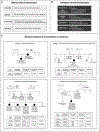Updates on Rare Genetic Variants, Genetic Testing, and Gene Therapy in Individuals With Obesity
- PMID: 38822963
- PMCID: PMC11694263
- DOI: 10.1007/s13679-024-00567-y
Updates on Rare Genetic Variants, Genetic Testing, and Gene Therapy in Individuals With Obesity
Abstract
Purpose of review: The goal of this paper is to aggregate information on monogenic contributions to obesity in the past five years and to provide guidance for genetic testing in clinical care.
Recent findings: Advances in sequencing technologies, increasing awareness, access to testing, and new treatments have increased the utilization of genetics in clinical care. There is increasing recognition of the prevalence of rare genetic obesity from variants with mean allele frequency < 5% -new variants in known genes as well as identification of novel genes- causing monogenic obesity. While most of these genes are in the leptin melanocortin pathway, those in adipocytes may also contribute. Common variants may contribute either to higher lifetime tendency for weight gain or provide protection from monogenic obesity. While specific genetic mutations are rare, these segregate in individuals with early-onset severe obesity; thus, collectively genetic etiologies are not as rare. Some genetic conditions are amenable to targeted treatment. Research into the discovery of novel genetic causes as well as targeted treatment is growing over time. The utility of therapeutic strategies based on the genetic risk of obesity is an advancing frontier.
Keywords: Genetic testing; Genetics; Monogenic obesity; Precision medicine; Severe obesity.
© 2024. The Author(s), under exclusive licence to Springer Science+Business Media, LLC, part of Springer Nature.
Figures

Similar articles
-
Rare genetic forms of obesity in childhood and adolescence: A narrative review of the main treatment options with a focus on innovative pharmacological therapies.Eur J Pediatr. 2024 Apr;183(4):1499-1508. doi: 10.1007/s00431-024-05427-4. Epub 2024 Jan 16. Eur J Pediatr. 2024. PMID: 38227053 Review.
-
The Genetics of Obesity.Pediatr Clin North Am. 2024 Oct;71(5):897-917. doi: 10.1016/j.pcl.2024.06.001. Epub 2024 Jul 9. Pediatr Clin North Am. 2024. PMID: 39343500 Review.
-
Heterozygous Genetic Variants in Autosomal Recessive Genes of the Leptin-Melanocortin Signalling Pathway Are Associated With the Development of Childhood Obesity.Front Endocrinol (Lausanne). 2022 Apr 29;13:832911. doi: 10.3389/fendo.2022.832911. eCollection 2022. Front Endocrinol (Lausanne). 2022. PMID: 35574020 Free PMC article.
-
Next-generation sequencing of the monogenic obesity genes LEP, LEPR, MC4R, PCSK1 and POMC in a Norwegian cohort of patients with morbid obesity and normal weight controls.Mol Genet Metab. 2017 May;121(1):51-56. doi: 10.1016/j.ymgme.2017.03.007. Epub 2017 Mar 29. Mol Genet Metab. 2017. PMID: 28377240
-
Rare genetic forms of obesity: From gene to therapy.Physiol Behav. 2020 Dec 1;227:113134. doi: 10.1016/j.physbeh.2020.113134. Epub 2020 Aug 14. Physiol Behav. 2020. PMID: 32805220
Cited by
-
The Interplay of UCP3 and PCSK1 Variants in Severe Obesity.Curr Obes Rep. 2025 Apr 26;14(1):38. doi: 10.1007/s13679-025-00631-1. Curr Obes Rep. 2025. PMID: 40281302 Free PMC article. Review.
-
Classification of childhood obesity using longitudinal clinical body mass index and its validation.Int J Obes (Lond). 2025 Jul 17. doi: 10.1038/s41366-025-01836-z. Online ahead of print. Int J Obes (Lond). 2025. PMID: 40670646
-
The expanding landscape of genetic causes of obesity.Pediatr Res. 2025 Mar;97(4):1358-1369. doi: 10.1038/s41390-024-03780-6. Epub 2024 Dec 17. Pediatr Res. 2025. PMID: 39690244 Review.
References
-
- Adult Obesity Prevalence Maps. In.: Centers for Disease Control and Prevention. National Center for Chronic Disease Prevention and Health Promotion, Division of Nutrition, Physical Activity, and Obesity; 2023.
-
- World Obesity Federation, World Obesity Atlas 2023. In.; 2023.
Publication types
MeSH terms
Substances
Grants and funding
LinkOut - more resources
Full Text Sources
Medical
Research Materials
Miscellaneous

